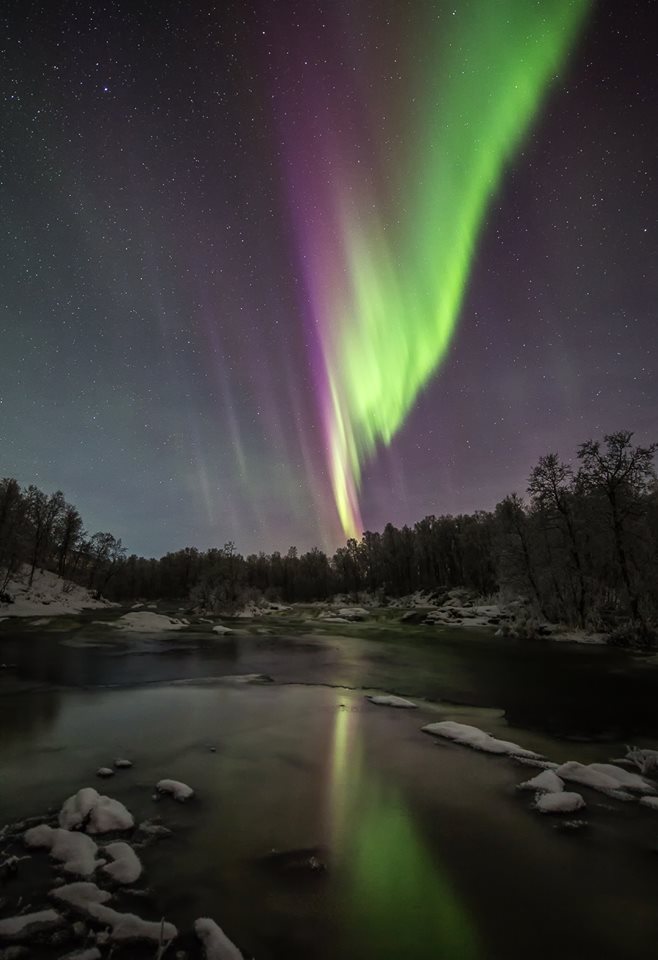Coronal hole stream, NOAA service interruption, filament eruption
Friday, 12 December 2014 20:58 UTC

A coronal hole high speed solar wind stream has arrived at Earth, slightly earlier than expected. Elevated geomagnetic conditions are being observed today and we even managed to reach the G1 minor geomagnetic storm level today. Anna McGee managed to capture this shot just over an hour ago from northern Scotland. Stunning! There was also a filament eruption on the Sun that launched a coronal mass ejection away from Earth and the NOAA SWPC announced that SWPC operations will be temporarily suspended due to facility power system maintenance on Saturday. This will affect the products on SpaceWeatherLive which use data from the NOAA SWPC. Flaring activity on the Sun continues at low levels (C-class only) and is expected to remain that way for the coming days.
Coronal hole stream arrival
Geomagnetic conditions are elevated in response to the arrival of a coronal hole high speed stream. The solar wind speed lies around the 600km/s which is high. The direction of the IMF fluctuated wildly over the past hours and this caused a period of minor G1 geomagnetic storm conditions.
Aurora displays are already being reported from high latitude locations like northern Norway. The image below was taken only a few hours ago by andershanssen.com. Amazing!

High latitude sky watchers should remain alert for auroral outbreaks as coronal hole effects will likely continue in the days ahead.
NOAA SWPC service interruption
The NOAA SWPC announced that tomorrow (Saturday 13 December) SWPC operations will be temporarily suspended due to facility power system maintenance. This is what the NOAA SWPC (click to expand) states on their website:
On Saturday, December 13th, SWPC operations will be temporarily suspended due to facility power system maintenance. The outage window will begin at 5:00 AM (instead of 6:00 AM as stated in the original notice) and end at 6:00PM Mountain Standard Time on that day. During this time all SWPC forecast and alert products, data products, and email Product Subscription Service will be suspended. SWPC's website will remain in service, but all data will be stale until the power outage has concluded. In the event of active space weather or a reasonable chance of active space weather, this maintenance will be postponed. Phone notification of key stakeholders and customers currently receiving that level of support will continue uninterrupted during this outage.
What this means for us is that some features on SpaceWeatherLive which rely on data from the NOAA SWPC will be unavailable for the duration of the power outage. The outage window ranges from 12:00 UTC on Saturday till 01:00 UTC on Sunday.
Filament eruption
The filament channel that we pointed out yesterday which was located between two coronal holes erupted this night in spectacular fashion. A large amount of solar plasma was hurled into space but the resulting coronal mass ejection was launched well north of the Sun-Earth line and does not have an earth-directed component.

Images: Anna McGee, NASA SDO, NASA/ESA SOHO and andershanssen.com
Video: NASA SDO.
Thank you for reading this article! Did you have any trouble with the technical terms used in this article? Our help section is the place to be where you can find in-depth articles, a FAQ and a list with common abbreviations. Still puzzled? Just post on our forum where we will help you the best we can!
Latest news
Latest forum messages
More topicsSupport SpaceWeatherLive.com!
A lot of people come to SpaceWeatherLive to follow the Sun's activity or if there is aurora to be seen, but with more traffic comes higher server costs. Consider a donation if you enjoy SpaceWeatherLive so we can keep the website online!

Space weather facts
| Last X-flare | 2025/03/28 | X1.1 |
| Last M-flare | 2025/03/31 | M1.2 |
| Last geomagnetic storm | 2025/03/27 | Kp5 (G1) |
| Spotless days | |
|---|---|
| Last spotless day | 2022/06/08 |
| Monthly mean Sunspot Number | |
|---|---|
| February 2025 | 154.6 +17.6 |
| March 2025 | 127 -27.6 |
| Last 30 days | 127 -25.7 |


